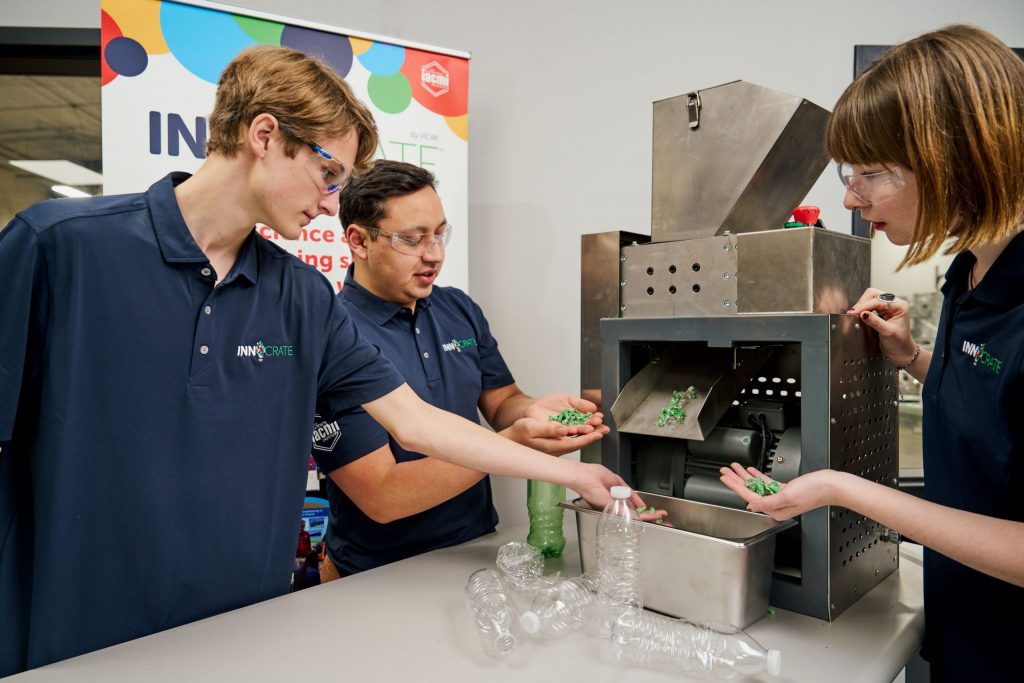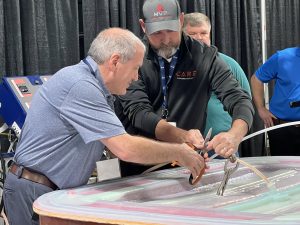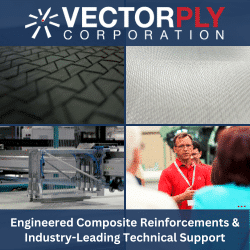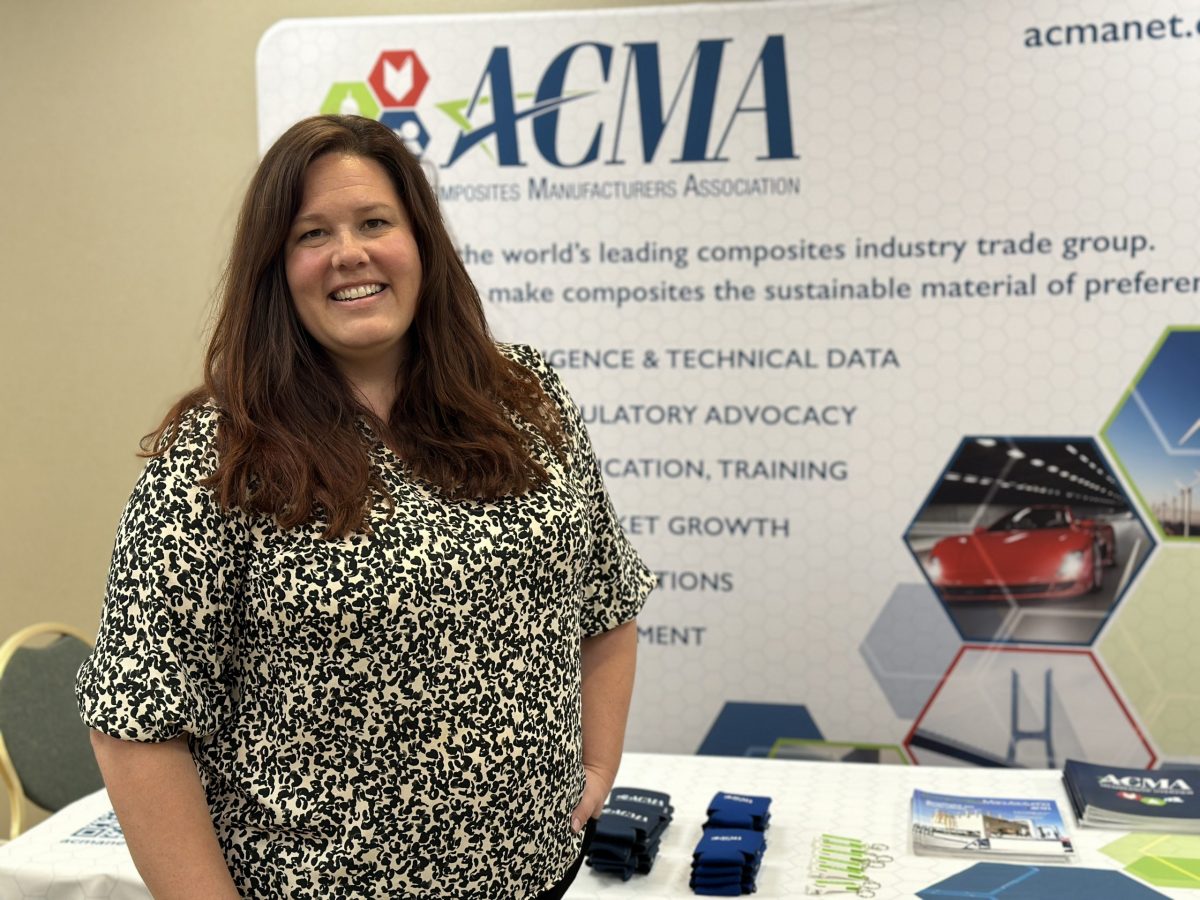

Closing the Skilled Workforce Gap
U.S. manufacturers in all industries will face a shortage of 2.1 million workers by 2030, according to the National Association of Manufacturing. Young people aren’t eager to fill that gap; a 2021 study conducted by the Utah System of Higher Education and the Kim Gardner Policy Institute found that 75% of the state’s high school students wouldn’t consider manufacturing as a potential career. Even when young people are interested in manufacturing jobs, they often don’t have the necessary skills or access to training to develop them.
Growing the composites manufacturing workforce requires a multi-faceted approach. Composites manufacturers, educational institutions, government agencies and workforce organizations are collaborating on a variety of training and job placement programs to address immediate needs. Looking down the road, they are exploring ways to get children and teens interested in and excited about STEM and related manufacturing activities.
State Support
Employers in Utah require skilled composites workers for the Air Force Sustainment Center, the F-35A Lightning II fighter and the Sentinel intercontinental ballistic missile at Hill Air Force Base, which together have added an estimated 65,524 jobs in 2023. Utah is also home to Hexcel, which produces more than 85% of the carbon fiber in the U.S., and to companies that manufacture a variety of composite products, ranging from aerospace parts and medical equipment to bicycles and guitars.
Recognizing the ongoing need for workers, Utah leveraged federal grants and a state appropriation to form the Utah Advanced Materials Manufacturing Institute in 2017. UAMMI brings together public, private, community, industry and education partners to enhance industry collaboration, share research knowledge, promote business opportunities and develop a skilled workforce.
UAMMI partnered with the Utah System of Higher Education (USHE) to gain funding for a Composite Materials and Structures master’s degree program. Launched in 2022 as a joint program between Utah State University and Weber State University, the program now has 16 students enrolled.
Under a grant from USHE’s Talent Ready Utah program and working with the Utah Governor’s Office of New Americans, UAMMI is piloting Return to Work, which brings immigrants and refugees with engineering or manufacturing backgrounds into the state’s manufacturing workforce.
“Skilled professionals who have been trained outside the United States are a potential new talent pool,” says Tulinda Larsen, UAMMI president. The 30 participants in the program’s first cohort have jobs at one of UAMMI’s 12 partner companies.
“We also have wraparound programs to help them be successful. One is mentoring for both the company and for the new Americans on work expectations,” says Larsen. “UAMMI is also working with a technical English program to upskill English proficiency and with a Utah company, OpenX, which has a library of virtual training courses for manufacturing.” During the year they’re in the Return to Work program, participants have free access to this library to reinforce existing skills and gain new ones.
To attract more women to the advanced materials manufacturing sector, UAMMI is collaborating with the Girl Scouts of Utah to help scouts earn the additive manufacturing badge developed by America Makes, which promotes additive manufacturing technology and education. UAMMI also sponsors welding camps for high school girls. In addition, UAMMI regularly conducts programs on women’s leadership in defense manufacturing to foster mentoring and career development.
Larsen says UAMMI has reached almost 10,000 students through its programs. “We have really been moving the needle here in the introduction of advanced manufacturing,” Larsen says.
Hands-on Learning
As a national Manufacturing USA Institute, a key focus of IACMI – The Composites Institute is to cultivate best-in-industry workforce development programs that provide the U.S. manufacturing workforce with skills of the future. A prime example is its Advanced Composites Career Pathways (ACCP) technician program supported by the Office of Naval Research (ONR). ACCP incorporates foundational courses based on the composite materials technology program at Utah’s Davis Technical College, plus additional courses tailored to regional needs. Local industry representatives review the curriculum and provide input on what skills are needed. ACCP is a hands-on program, with almost 90% of the coursework conducted in the lab.
IACMI has ACCP partners at colleges in Alabama, Florida, New York, Tennessee and Puerto Rico. With support from the Department of Energy (DOE), training sites will open in Colorado and Michigan in 2025. In addition, IACMI will soon offer a 10-week internship program supported by the DOE, including industry placement in one of the institute’s 150-plus member companies across the U.S.
“One hundred percent of our [previous] IACMI interns either graduated with a job offer in industry or have been accepted into a graduate program,” says Joannie Harmon, IACMI’s vice president of workforce development.
For TPI Composites Inc., the internship program has provided continuity on technical innovation project collaborations with IACMI university partners. “We are simultaneously filling our workforce with specific entry-level technical expertise that is extremely difficult to recruit through job boards and word of mouth,” says Stephen Nolet, senior director of innovation and technology.
Darren Foster, who interned at TPI for five months in 2018 and joined the company two years later, is a great example. “He came to TPI on day one with a full complement of technical skills in the materials technology we apply every single day,” says Nolet.
Foster, now a lead materials engineer, said his IACMI internship was an invaluable experience.
“I quickly transitioned roles from student to intern and began working on real-life projects with responsibilities and deadlines,” says Foster. “This industry operates at a much faster pace than I anticipated, and without my internship experience, it would have been difficult to adjust to life at TPI so quickly and easily.”
IACMI is also scaling up a new Metallurgical Engineering Trades Apprenticeship & Learning (METAL) program in conjunction with the Department of Defense’s (DOD) Industrial Base Analysis and Sustainment program and industry partners. METAL aims to develop a workforce trained in metal casting and forging skills critical for national defense. The program is within IACMI’s purview since metal machine tools are used to create composite tooling, and composite materials are often used with metals to optimize product performance.
“We are hearing from our industry and strategic partners that more and more they need employees to have multiple skills, such as understanding processes for working with multi-materials,” says Harmon.
The METAL curriculum will encompass a variety of learning options: upskilling programs for workers already in the trades, metallurgical engineering certification and degree programs, apprenticeships and internships.
The apprenticeship programs will be one to four years, depending on the occupation and difficulty of skills needed. They will be structured to meet industry and government requirements and customized for employers’ workforce and training needs.
METAL’s short-term training modules, which are already available, are modeled after another successful IACMI/DOD training program, America’s Cutting Edge. ACE consists of hands-on bootcamps and several self-paced, online introductory courses, including CNC Machining, Composites Unit 1, Metrology and Cybersecurity.
Applicant Outreach
Building the manufacturing workforce requires three key steps – alerting people to training opportunities, getting them enrolled in programs and helping them land jobs once they’ve completed training.
The national non-profit organization Jobs for the Future (JFF) will assist IACMI in these efforts and in content development for the apprenticeship component of the METAL program. JFF has worked with more than 100 manufacturing companies to place more than 2,000 people into apprenticeship programs.
“[METAL] is going to help support the outreach and recruitment of employers and partners for the selection and hiring of participants for apprenticeships. Then we’re going to help IACMI think through building their strategy for getting different types of workers into metallurgy, casting, forging and those types of occupations,” says Myriam Sullivan, senior director in the Center for Apprenticeship & Work-Based Learning at JFF.
JFF provides a broad scope of services to its workforce development partners, which range from local community-based organizations to individual companies struggling to increase their workforces.
“If a company’s HR department is having trouble recruiting workers, we might work with them to establish an apprenticeship program or to help with retention issues. We might provide advisory services or technical assistance around workplace culture,” Sullivan says. “We really customize programs to employers’ needs and provide services that will work for them.”
Prioritizing an inclusive workplace and increasing efforts to hire diverse employees can also help companies meet hiring goals. Sullivan says manufacturers whose workforce includes women or people of color should get those employees’ stories out to the community. “That can greatly help with recruiting and attracting other more diverse groups to the industry,” she says.
Manufacturers should begin now to develop their future workforce.
“They should go into our K-12 systems with campaigns that raise awareness so young people can see themselves in these occupations,” Sullivan advises. “They should dispel the myths that exist about the [manufacturing] sector by sharing what the employers provide to help with job quality and with wage advancement potential.” Manufacturers can talk about the various pathways that show the full breadth of job opportunities in the manufacturing sector, whether people like to work with their hands or with computers.
Manufacturers face a lot of competition for workers from industries like technology, healthcare and finance. To grow the workforce, the entire composites industry must play an active role in showing people its possibilities and its potential for well-paying, rewarding careers.
Mary Lou Jay is a freelance writer based in Timonium, Md. Email comments to mljay@comcast.net.

IACMI – The Composites Institute has provided products and processes training to more than 2,000 participants in conjunction with companies such as Magnum Venus Products and Composites One.
Photo Credit: IACMI

In partnership with the Department of Defense, IACMI is scaling up a national CNC machining training program called America’s Cutting Edge for both metals and composites.
Photo Credit: IACMI
An Early Start
IACMI – The Composites Institute collaborated with industry, educators and the University of Tennessee, Knoxville, to develop InnoCrate, a series of STEM activity kits designed to expand the horizons of K-12 students while equipping them with foundational knowledge for careers in composites, CNC machining and metal casting. Participating educators receive crates that contain supplies for classroom experiments, including some composites-based activities. The program also provides teacher training, guidebooks and videos to support age-appropriate activities.
In addition, IACMI partnered with the Office of Naval Research to develop SkillCrafters, a “Shark Tank” style program for middle school and high school students. The project-based learning program seeks to engage kids with advanced technologies, familiarize them with the principles of entrepreneurship and expose them to career pathways that lead into the advanced manufacturing sector.
SkillCrafters’ design-centered approach allows students to apply what they learn about technology and entrepreneurship to a real-world challenge. In 2022, for example, SkillCrafters’ participants in two Tennessee high schools came up with ideas for a composite motorcycle helmet, recyclable prosthetics and a brain chip to help people with speech impediments.
“SkillCrafters and InnoCrate educate youth about various composite materials through hands-on activities where they can see, feel and experience the true purpose of such materials in their everyday lives,” says Harris.
Increasing Certification Opportunities
When the Maine Composites Alliance (MCA) conducted a workforce analysis in 2023, it revealed the biggest gaps in the composites’ workforce were operators and technicians. With funding from the Maine Space Grant Consortium, Andrew Schoenberg, CEO of Maine Polymer Engineering Solutions and adjunct professor at the University of Southern Maine, led efforts to increase the number of ACMA Certified Composites Technicians (CCTs) and instructors in the state.
Schoenberg and his team, including Drew Sfirri from the Composites Engineering Research Lab and Skip Orne, now with KO Composites, focused on improving the composites curriculum at four technical high schools. “None of the instructors in these programs were ACMA certified, and there was little to no communication or interdependency amongst the schools,” says Schoenberg.
The team worked with the instructors to share educational materials, including ACMA’s CCT curriculum and training methodology. “The four high school instructors had varying degrees of knowledge and experience in composites, so this sharing of ideas and methods was extremely valuable,” he says. Two of the instructors took the training necessary to become certified CCT technicians, and one became a certified instructor. Several students from these school programs have since completed ACMA’s CCT training program.
In addition, Schoenberg’s team used grant funding to offer ACMA’s CCT training programs to people already working in Maine’s composites industry. Eleven people successfully completed the program last August.

SUBSCRIBE TO CM MAGAZINE
Composites Manufacturing Magazine is the official publication of the American Composites Manufacturers Association. Subscribe to get a free annual subscription to Composites Manufacturing Magazine and receive composites industry insights you can’t get anywhere else.










